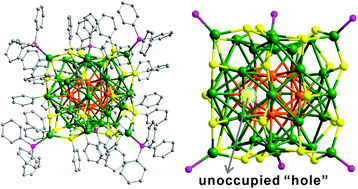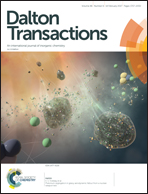Peculiar holes on checkerboard facets of a trigonal prismatic Au9Ag36(SPhCl2)27(PPh3)6 cluster caused by steric hindrance and magic electron count†
Abstract
We report herein the synthesis and structure of a 45-atom trigonal-prismatic Au–Ag bimetallic nanocluster, formulated as Au9Ag36(SPhCl2)27(PPh3)6, based on single-crystal X-ray crystallographic determination. The structure can be described as a core–shell structure with a tricapped trigonal prismatic (ttp1) Au9 core encaged in a larger (frequency-two) tricapped trigonal prismatic (ttp2) Ag30 shell. The cluster is terminated by six Ag(PPh3) moieties which, along with ttp2 and 27 thiolates, constitute the outer trigonal-prismatic (TP) shell. Each of the three nearly coplanar yet severely distorted “square” faces of TP contains 13 Ag atoms which are arranged in a way reminiscent of the (100) face of a face-centered cubic (fcc) structure. Of the 30 edges formed by these quasi-(100) faces of the TP, only 27 are bridged by the thiolate ligands; three are vacant, one on each “square” face. It is believed that these peculiar vacant ligand sites are caused by steric hindrance of the thiolate ligands in combination with the superatomic electronic shell closing of 1S21P61D10 rendering 9(ttp1) + 30(ttp2) + 6(TP) − 27(SR) = 18 jellium electrons.



 Please wait while we load your content...
Please wait while we load your content...